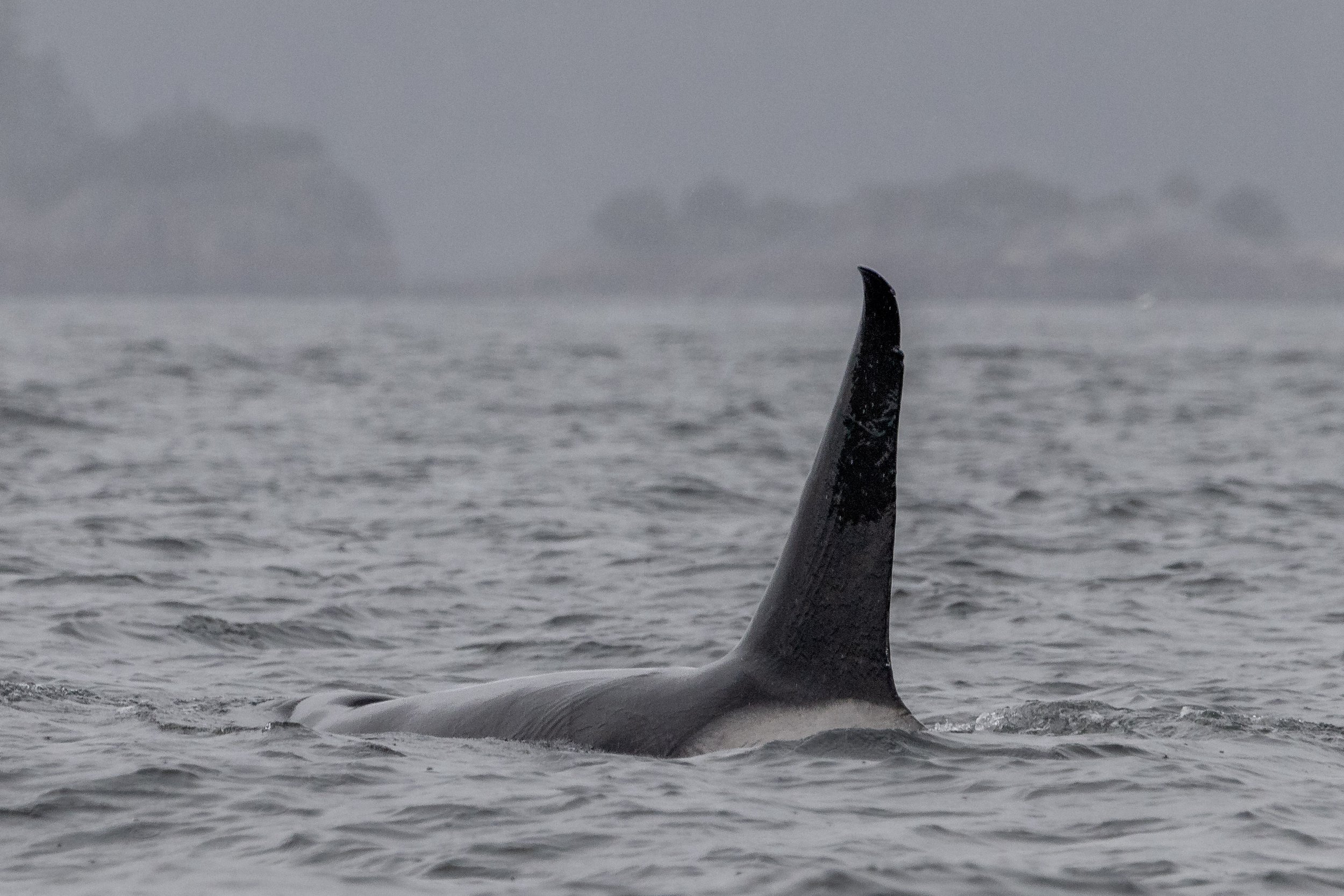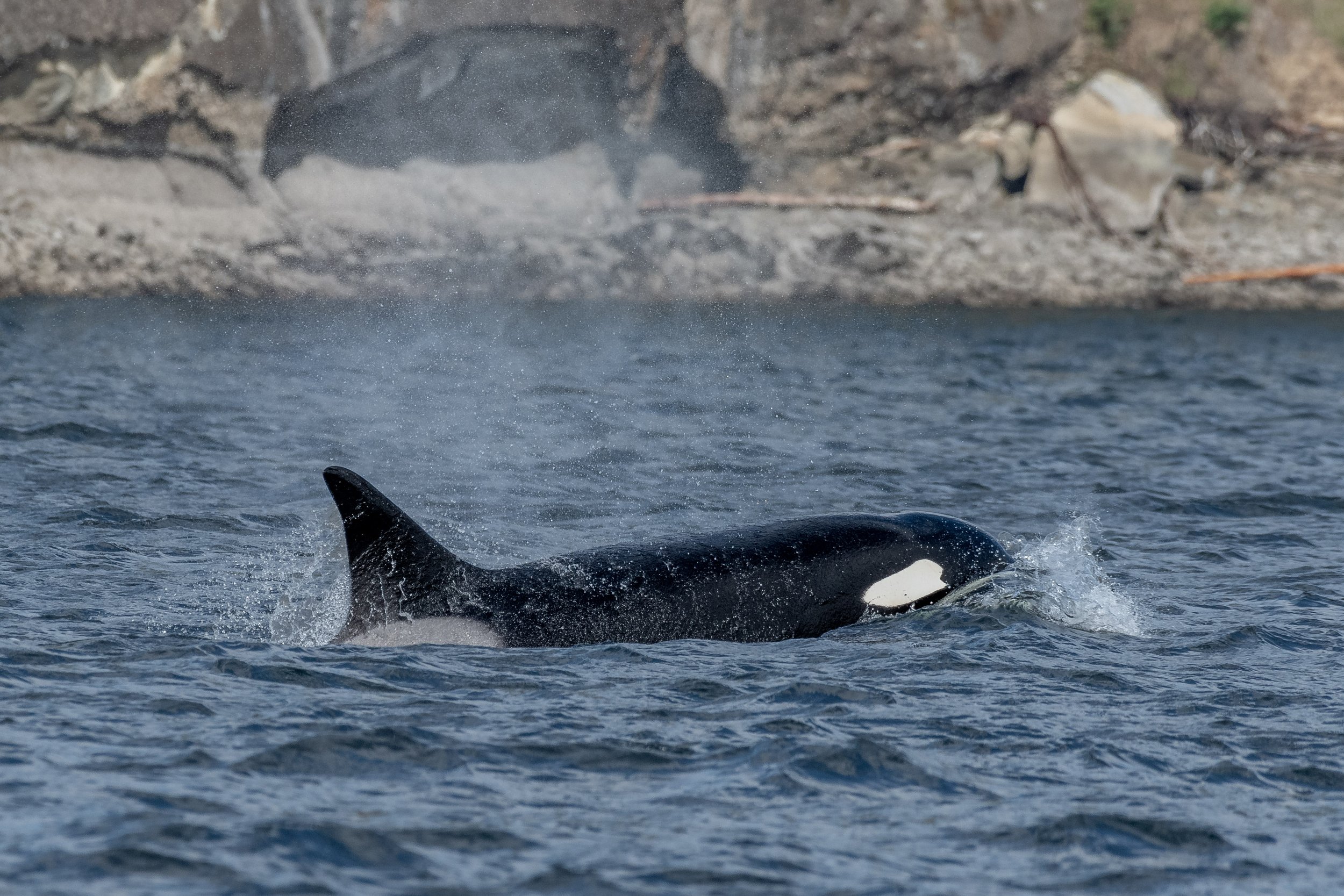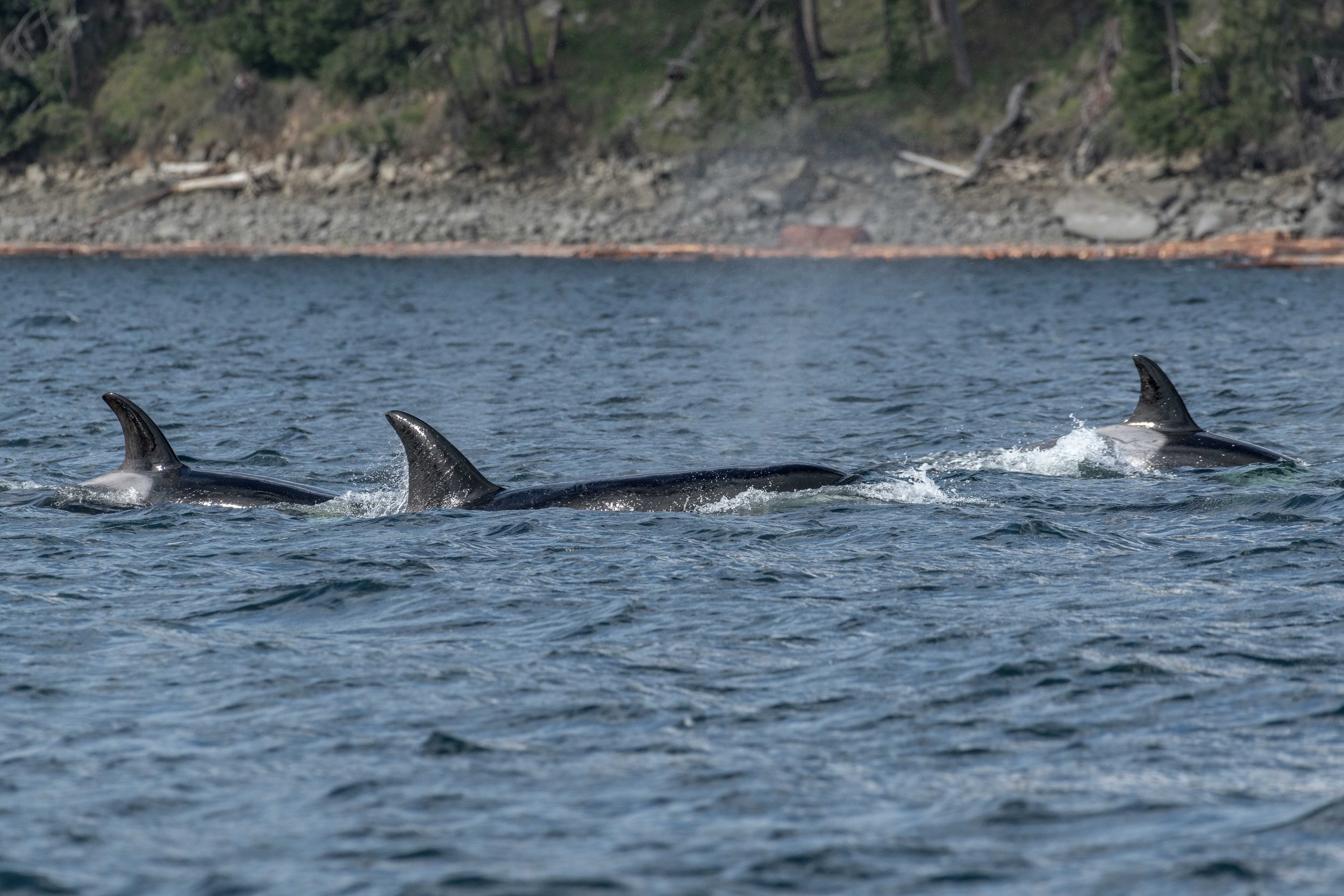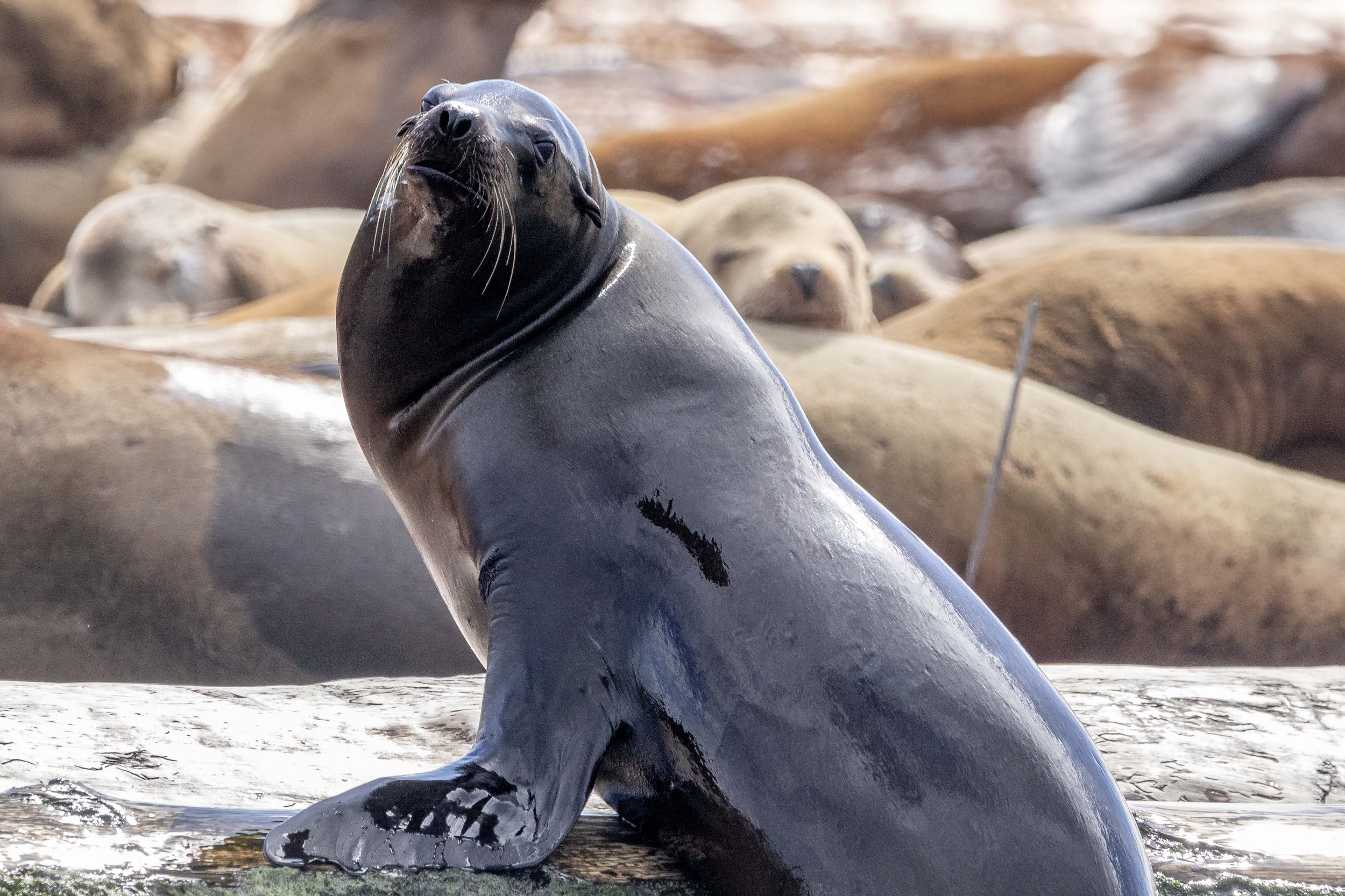April 28, 2024 - A fun modge podge of orca!
Today we started our day by stopping to have a peek at some wildlife. One of our boats stopped by the White Islets. As per usual, there were several sea lions both large and small high up on the rocks. The White Islets is a popular haul out for them, or a good spot for them to rest and relax before they need to go hunting. Of course, when you have this many animals around, it’s not always quiet relaxation. Sometimes the large males will fight to assert dominance and to claim the best spots on the rocks. This behaviour is also used to woo ladies in preparation for the mating season.
Our other vessel took a bit of a different route to maximize the ground we covered to have our best chance at success finding whales today. Their first stop was to see a bob of Harbour Seals lounging on the seaweed-covered rocks. A juvenile Bald Eagle was also spotted here, watching the waters from the rocks. Bald Eagles do not get their signature white/bald head until they are about 5 years old. Before that point, their head plumage is usually brown with white streaks through it like this individual!
There were several Harlequin ducks meandering along the edge of the water, likely looking for snacks. While it is hard to hear while you are on a boat with a group of grumbling sea lions nearby, Harlequin ducks are a type of waterfowl that does not make the typical “quack” sound most people imagine when you think about ducks. Instead, they make a mouse-like squeak!
After departing our wildlife we continued onwards and had our first whale stop of the day - a well-known bull male named Harbeson:
T087 Harbeson ♂ (~1962)
Harbeson is kind of a big deal. While he isn’t usually the most energetic of whales, he is believed to be around 62 years old. Not only does this beat the general life expectancy of a male orca (roughly 30-50 years old), but he is also believed to be the oldest male orca in the entire Transient/Bigg’s orca population! After watching Harbeson for a bit we continued onwards, excited as we left as we got word of another potential sighting near our home port!
It didn’t take too long for us to locate these whales quickly travelling together through Northumberland Channel - the waterway right outside the Nanaimo harbour. They were busily zig-zagging and hunting while we watched, but we were able to identify this T-party (group of multiple orca pods travelling together as the below whales:
T071B1 Zengo ♀ (2013)
T071B2 Tasli/Nemo ♂ (2018)
T086A3 Tyndall ♀ (2011)
T086A3A (2024)
T124A2 Elkugu ♀ (2001)
T124A2A Agafia ♂ (2013)
T124A2B Litton ♀ (2016)
This is probably one of the most interesting groups of whales we have seen for a T-party to date! T086A3 Tyndall and her calf were travelling with the rest of their matriline very recently. We are not sure why she and her calf decided to travel solo instead. It’s a similar situation for T071B1 Zengo and T071B2 Tasli/Nemo. Their mother, T071B Hood, was travelling together with them recently. Hood does have a new calf of her own this year (T071B3), but it is very uncommon for a mother orca to break off from the rest of her offspring, especially when her matriline is still relatively small. While we don’t know what is going on with these funky pod dynamics, they all seemed to be in good health and thriving during our encounter!
All eyes were on the youngest member of this T-party today. T086A3A, Tyndall’s first calf, was excitedly and quickly travelling to keep up with the other party members. This calf is looking great - it’s already very round just like how you want an orca to be! Tyndall appears to be a great mother and we are so excited to see this little one grow up!
Once we left the T-party we headed back towards home port to wrap up another very successful day out on the water!
Photos by Marine Naturalists Aly Kohlman and Lucy Willis.
T087 Harbeson. Photo by Lucy Willis.
T087 Harbeson. Photo by Aly Kohlman.
T087 Harbeson. Photo by Aly Kohlman.
T124A2B Litton. Photo by Aly Kohlman.
T124A2A Agafia and T124A2B Litton (dorsal fin tip). Photo by Aly Kohlman.
T086A3 Tyndall. Photo by Aly Kohlman.
T071B2 Tasli/Nemo. Photo by Aly Kohlman.
T071B1 Zengo. Photo by Aly Kohlman.
T086A3 Tyndall has a VERY distinct dorsal! Photo by Aly Kohlman.
T124A2 Elkugu. Photo by Aly Kohlman.
T124A2B Litton and T124A2 Elkugu. Photo by Aly Kohlman.
Little T086A3A and their mother T086A3 Tyndall. Photo by Aly Kohlman.
Little T086A3A and their mother T086A3 Tyndall - the little one is still a bit orange! Photo by Aly Kohlman.
Little T086A3A and their mother T086A3 Tyndall. Photo by Aly Kohlman.
T071B2 Tasli/Nemo. Photo by Aly Kohlman.
T071B2 Tasli/Nemo, T124A2A Agafia, and T124A2B Litton. Photo by Aly Kohlman.
T124A2 Elkugu and her son T124A2A Agafia. Photo by Lucy Willis.
T124A2A Agafia. Photo by Lucy Willis.
T124A2 Elkugu - her massive “pacman”-shaped eyepatch is a good way to confirm her ID! Photo by Lucy Willis.
A giant pile of whales! Left to right: T124A2 Elkugu, T071B2 Tasli/Nemo (front), T086A3A (middle), T086A3 Tyndall (back), and T124A2A Agafia. Photo by Lucy Willis.
A young eagle behind a bob of Harbour seals. Photo by Lucy Willis.
Sleepy Harbour seals. Photo by Lucy Willis.
Grumbling away! Photo by Lucy Willis.
Drowsy after their nap. Photo by Lucy Willis.
Someone just came out of the water! Photo by Lucy Willis.
The grumbly sea lions of the White Islets. Photo by Aly Kohlman.
A male and female Harlequin duck. Photo by Aly Kohlman.
A banded Gull - look at all that bling! Photo by Aly Kohlman.
A flock of Harlequin ducks. Photo by Aly Kohlman.
This juvenile Bald eagle caught a fish while we watched! Photo by Aly Kohlman.
It started snacking right away. Photo by Aly Kohlman.































